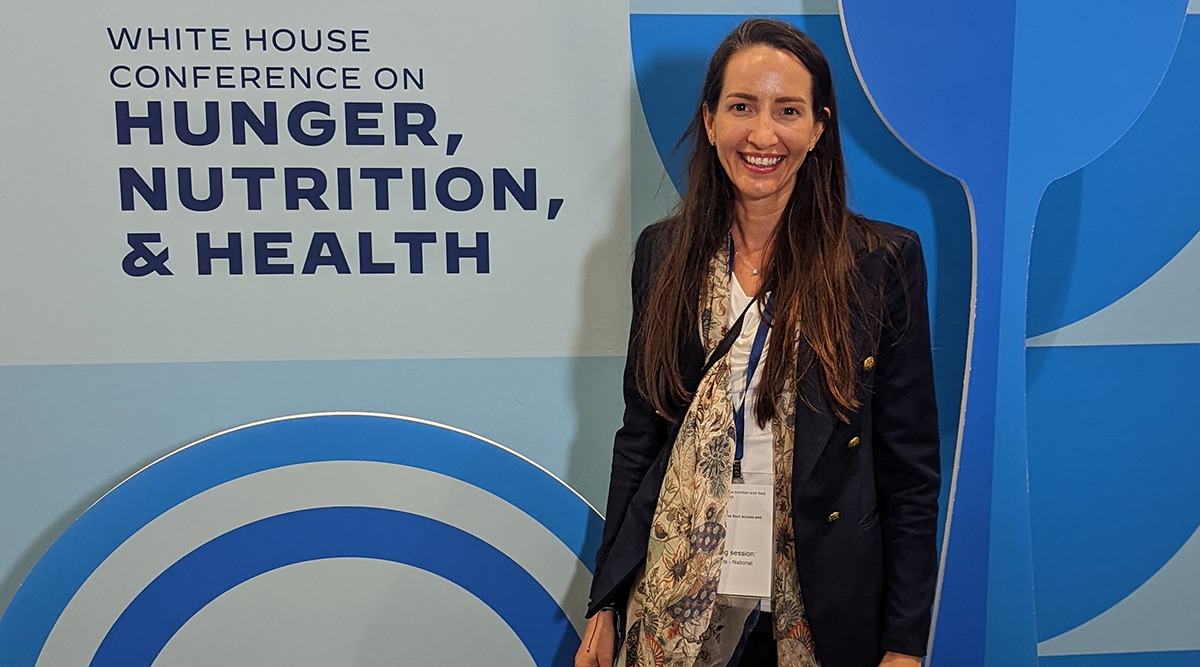
A Roadmap for Combating Food Insecurity and Promoting Health
IFT’s Anna Rosales attended the White House Conference on Hunger, Nutrition, and Health. Here are her key takeaways.

In late September, 600 leaders from across the food system came together in Washington, D.C., for the White House Conference on Hunger, Nutrition, and Health. They were joined by a common purpose and an ambitious goal: to strategize, share, innovate, and commit to ending hunger and reducing diet-related diseases in the United States by 2030. I was privileged to be among them as a representative for IFT.
Convening stakeholders and changemakers in one auditorium created an energy that was palpable. I met researchers, chefs, farming advocates, food service gurus, policy experts, student leaders, and more. Each person was there for a reason and eager to introduce themselves and spark a conversation.
With food insecurity affecting an estimated 38 million Americans, we coalesced around the Biden Administration’s national strategy, which reads like a call to action: “The U.S. is facing an urgent, nutrition-related health crisis,” it warns. “The consequences of food insecurity and diet-related diseases are significant, far-reaching, and disproportionately impact historically underserved communities.” These powerful words are backed by five concrete action areas, or “pillars,” to move the country forward—from promoting greater food access and affordability to bolstering nutrition and food security research funding.
The challenges are great, but real solutions are gaining ground. One of the most promising outcomes from the conference is the commitment to “food as medicine”—the idea of better integrating food and nutrition into medical training and the healthcare system. This could translate into more comprehensive nutrition education for physicians, produce prescriptions, and insurance-covered medical foods to help prevent or manage diseases. Imagine a patient with celiac disease who can have certain foods covered by their insurance plan or a prescription for fruits and vegetables that comes from a physician—one of the most trusted individuals in a person’s life. I expect to see “food as medicine” integrated into future legislation and policy. Though measurement and evaluation will be essential to bringing it forward at scale, the concept holds the potential for big impacts.
Another exciting highlight: the conference sparked the Food and Drug Administration’s long-awaited update on its definition of “healthy” (indicating when foods can be accurately labeled as such, based on nutrient-content criteria). IFT's Science and Policy team will be collecting member input and submitting comments on the proposed rule in the coming month—stay tuned to IFT.org to learn more. Additionally, the national strategy includes a push for front-of-package labeling that will help consumers make healthier food choices through greater transparency. I expect that this labeling practice will soon be an FDA priority.
It’s been more than 50 years since President Richard Nixon pledged to “put an end to hunger for all time,” convening a landmark conference in 1969 that ushered in key anti-hunger initiatives like the Special Supplemental Nutrition Program for Women, Infants, and Children (WIC), the Supplemental Nutrition Assistance Program (SNAP), and the National School Lunch Program (NSLP). Those programs still resonate today, and there were even calls at the conference for some to be expanded. But we need to do more. The COVID-19 pandemic exacerbated hunger in America—in 2021, one in 10 households reportedly experienced food insecurity. Diet-related illnesses like heart disease, obesity, and stroke remain some of the leading causes of death. We’ve got a lot of big things to do to reverse these trends, and we don’t have 50 more years to do it.
The White House is calling for change on a tight timeline—ending hunger in just seven years. That deadline does not frighten me; it makes me excited. The question is how best to get there. The conference made clear something we’ve known for a long time: within the food system, we’re often working in silos. We need to change the way we research, create partnerships, and build collaborations. It’s easy to say, yet harder to do.
As we transform the way we work, I believe that IFT has a unique role to play in helping break down those silos and live out our vision of connecting global food system communities. We all know that food brings people together, but food science is what brings together the food system.
If you missed the White House Conference, you can still check out the agenda, listen to sessions, and explore its pillars on the conference website. You are also invited to join the ongoing conversation at a special IFT panel discussion on Monday, October 24, at 2 p.m. CT titled “The Role of Food Science in the White House Conference.” Special guests include Sara Bleich, the USDA’s director of nutrition security and health equity.
About the Author
Anna Rosales is IFT’s senior director of government affairs and nutrition.
